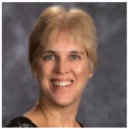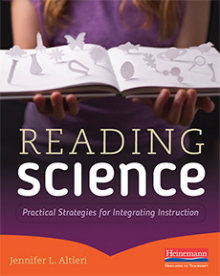Ideas to Improve Students’ Science Literacy
Reading Science: Practical Strategies for Integrating Instruction
By Jennifer L. Altieri
(Heinemann, 2016 – Learn more)

Scientific literacy is essential for academic achievement in science. The concept is not a new one. It has been around since post WWII, and is now included as part of the digital age literacy skills.
Jennifer Altieri’s book, Reading Science: Practical Strategies for Integrating Instruction, sets a goal of strengthening scientific knowledge and making scientific content accessible to all students. That is a tall order and an impressive goal. Altieri’s challenge to science teachers is stated succinctly on page 2:
In order to gain scientific knowledge, our students must be able to understand scientific material. This requires our students to possess the literacy skills necessary to read, view, and articulate scientific thoughts.”

► Summaries presented in the “Before Moving On” sections of each chapter.
► Regular paragraphs that prompt readers to consider “What Does This Mean for You?”
► “Think About” and “Take Action” sections throughout the book that encourage readers to reflect on teaching techniques used in their classrooms and to consider using some other ideas. The suggestions are good starting points for book study members to get the conversation progressing around the science-literacy connection.
► I know books should not be judged by their covers, but this one caught my eye and made me look closer.
This book would also be important reading for preservice teachers. The author is an associate professor of a university and an author of other books on literacy, so she’s attuned to the needs of students preparing to be teachers.
Detailed strategies for teaching vocabulary
One section of the book I will frequently use is the chapter on vocabulary. Altieri provides a variety of ways to address science vocabulary so that students are engaged in the process of learning the meanings of terms in order to make science more comprehensible.
Chapter 3: “Building Scientific Vocabulary Knowledge” provides many strategies to do just that. Vocabulary is first broken into tiers depending on the type of word. Words students encounter daily are Tier One. Words encountered in various content areas are Tier Two and need to be taught. Tier Three words are only seen in specific content areas and require far more reinforcement.
I have taught science for over two decades and have expanded my techniques as I evolve as a teacher, but had not thought about these three tiers quite so specifically. My copy of the book is covered with highlighter on different types of vocabulary building techniques such as a science term scavenger hunt, list-group-label, and a group knowledge-rating sheet.
Another favorite part of this text is the Appendix, which holds eight reproducible pages that make the task of teaching vocabulary, evaluating texts, and finding educational twitter chats easier. Throughout the book’s five chapters there are references to methods that would be especially helpful for ELL students and those with learning disabilities. Being the ELL coordinator for my small district makes me particularly alert to suggestions like these that can be readily applied.
The value of planned redundancy
While the book includes many concepts I was already familiar with, it also includes some that are new to me such as how to interpret images and to sort them by purpose.
There seemed to be some planned redundancy in the author’s narrative that reinforced what I had already read and might be skipped over by seasoned teachers. If this book is used in teaching methods classes, however, the repetition will be helpful. Looping information over a semester-long book study might also be helpful to aid in retention of content.
I would like to have found more specific suggestions in some parts of the book. For example, on page 11 teachers are encouraged to assist students “… in navigating images so that they can use the information they gain from the images to strengthen their scientific knowledge.”
The text goes on to mention critical examination of images and the need to provide opportunities for student practice, but does not tell teachers how to accomplish this. It may be obvious to others, but, as is the case with many other ideas that are spelled out with handouts to accomplish the goals, more details might also be provided here.
Cross-curricular projects benefit a crowded curriculum
The book lends itself to literacy minded, cross-curricular projects. Working with the ELA teacher, we can tackle some of the suggestions with activity-based learning that students would develop in both science and language arts classes. I found myself thinking there is just not enough time in a school year to approach scientific literacy, include all of the science content, and do the kind of job I want to do. There is an obligation to prioritize class content.
I think passing over science content to decide what type of image is used and why will not take precedence over learning science in my classroom. That may be blasphemy, but it is my reality. A limited number of hours to teach along with so many essential standards make for an already busy school year. All of this detail would not fit.
Yet with cross-curricular projects, with two subject-area teachers to tackle the job, it does not seem so overwhelming. Although I agree that literacy is the core of all curricula, it is harder to do wholistically than it first appears. Even so, by gaining the insights and applying some strategies found in Reading Science, teachers can make progress on this important issue.
south central Kansas. Joyce enjoys presenting at workshops about ways to implement the NGSS.
For more than 38 years Joyce Depenbusch has been involved in education in one way or another. As an elementary and middle school teacher and as the wildlife education coordinator for Kansas, she has combined her love of children and science. Currently, she is a middle and high school science teacher in rural


































